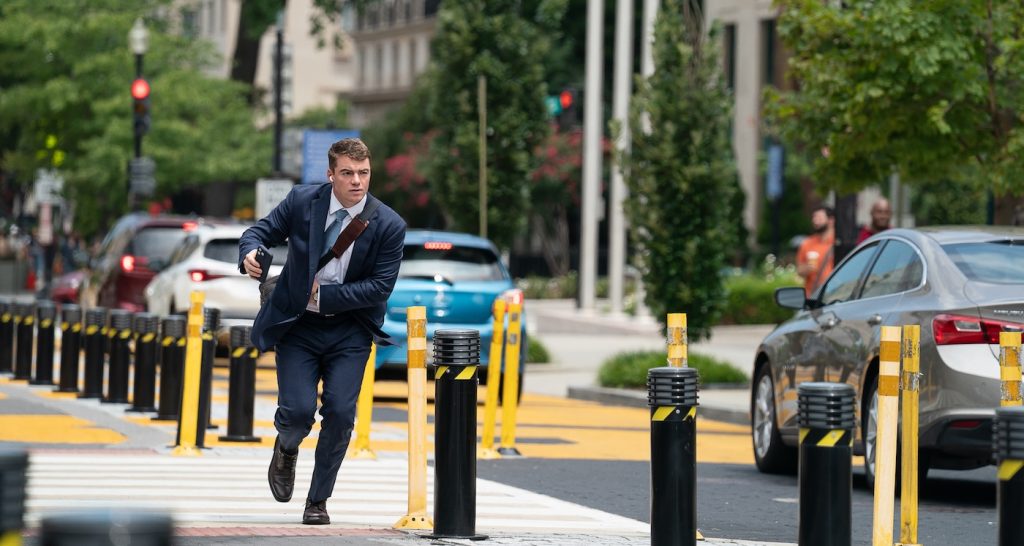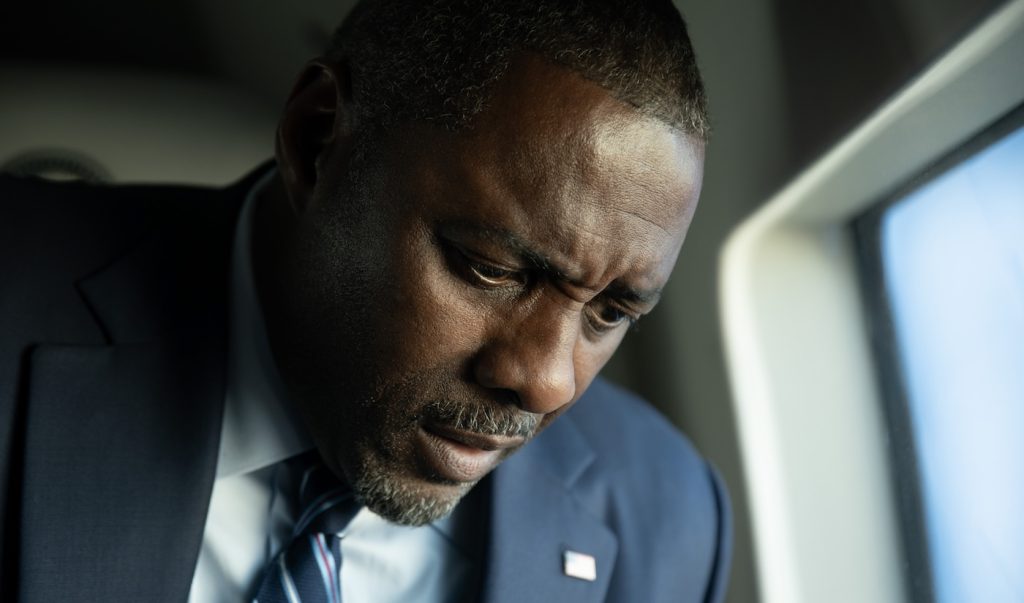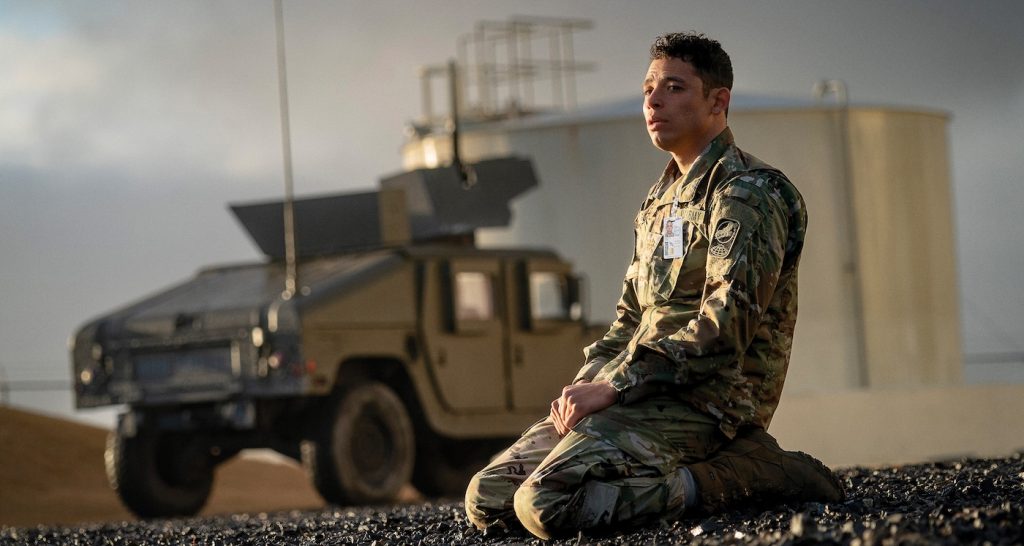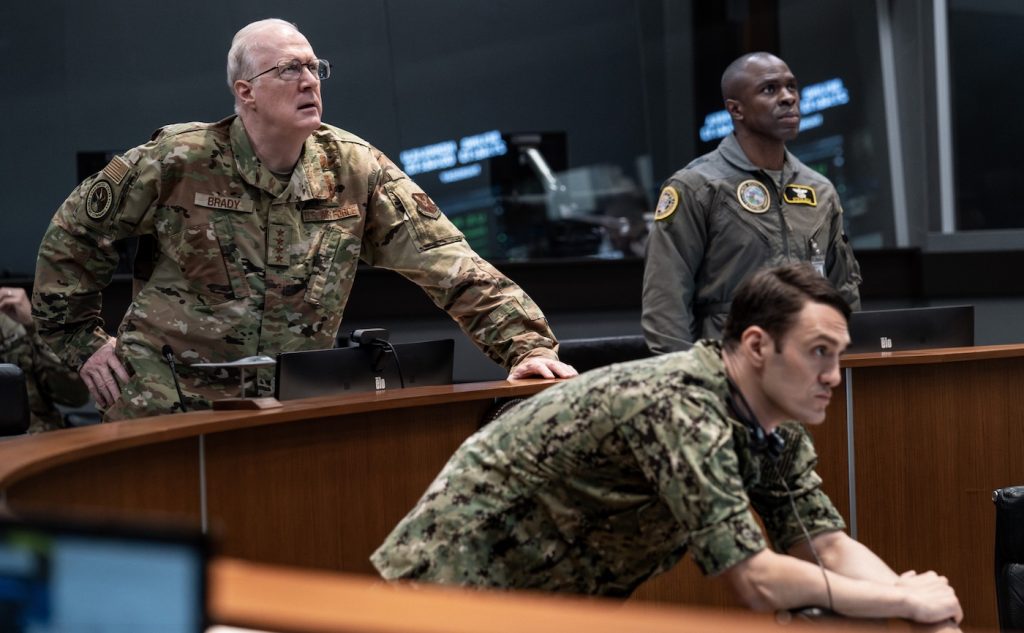“A House of Dynamite” Scribe Noah Oppenheim on His Real-Time Nuclear Thriller’s Emotional Stakes & Shocking Ending
Spoilers below.
News veteran turned Hollywood scribe Noah Oppenheim (Jackie, Zero Day) has penned a new edge-of-your-seat thriller in A House of Dynamite, a cautionary tale about nuclear weapons and those in charge of them. Helmed by Oscar-winner Kathryn Bigelow (The Hurt Locker, Zero Dark Thirty), the film stars a dynamic ensemble that includes Idris Elba, Rebecca Ferguson, Jared Harris, and Tracy Letts. It premiered at the Venice Film Festival in early September to a flood of acclaim.
The doomsday plot unfolds in real-time, with the U.S. government scrambling to intercept an unidentified nuclear missile aimed at Chicago. Spoiler alert: It doesn’t. Oppenheim focuses on the frantic 18-minute window between launch and impact, weaving a non-linear timeline told in three chapters, all building towards the president’s (Elba) fateful choice: retaliate or stand down.
When asked what drove the stakes of each chapter, Oppenheim tells The Credits, “We always wanted to end each act on the question being put to the president of what he wanted to do. We wanted each act to unfold in real-time so that the audience had a visceral sense of how short a period of time a decision like this would have to be made in. And we wanted to structure the movie in such a way that the audience climbed the ladder of responsibility and authority.”
Below, we ask the writer about how he developed the emotions, the controversial ending, and that surprising Angel Reese cameo.
The story plays out like a handbook to America’s nuclear weapons response. How did you want to weave in the emotional stakes for these characters as they try to do their jobs?
It was important to try to carve out moments for each of these characters’ humanity to shine through. Once you’ve made the decision to tell a story in real time about a nuclear missile hurtling towards the United States, you have limited real estate to do that with from a script standpoint. Each one of the characters responds differently, as I think would be the case in real life. Some people want to reach out to their loved ones, but some are just so caught up in their jobs that they don’t even have the opportunity. Some remain completely stoic. Some crack.
Rebecca Ferguson’s role as Captain Walker is terrific. She’s this no-nonsense career woman, but still a mother first. Did you see her character evolve outside the script?
A lot of it was baked into the script, but then was also discovered by the actors on set in terms of what emotion they chose to play in different moments. The dialogue might be really professional, but their emotional expression might reflect something differently. There was always a scene with Rebecca’s character before she went to work with her son. In the process of filming that scene, the little boy was playing with a toy dinosaur. And so, Rebecca and Kathryn on set decided to have her take the dinosaur with her. And that became kind of a totem and expression of her connection back to her kid.
Jared Harris’s Secretary of Defense Reid Baker is another standout. How did you see the character during the writing process?
From the very beginning, one of the things that Kathryn and I discovered in our research process was that the folks at the top of the decision-making chain are often the least prepared to deal with this. So the idea was to have a character who is well-intentioned, but this is not something he has spent his life contemplating. He’s a character who’s gone through something in his personal life. He’s just lost his wife, and he’s got a somewhat strained relationship with his daughter. And how does a person like that respond in a moment like this, particularly when he finds out his daughter is in the target city?
And the choice Baker made was not to tell his daughter.
The decision to tell her or not is one of those kind of great dinner party conversation dilemmas that you can pose around the table. If a nuclear missile is going to hit Chicago, and she’s in Chicago, and she’s got four minutes, what is she going to do or where is she going to go? So would you rather have her walking to rehearsal with her boyfriend happy? Or would you rather have her spend the last four minutes of her life terrified?

We have to ask you about the ending. In the final moments, we see the president just about to make a decision on whether to strike back or not, and it cuts to black. Is there an alternative ending, or was that a deliberate choice to stir a conversation?
Kathryn has spoken pretty publicly about her desire to invite the audience to lean in and have a conversation. And if you think about the menu of options that we have around the end. You could end with the president deciding not to retaliate. You could end up with Chicago being obliterated. You could end with the missile that hits Chicago being a dud, which does sometimes happen. And then everyone is fine, and we all go back to our lives. You could end with the mushroom cloud or a hundred mushroom clouds destroying the planet. The problem with all of those endings is that it kind of lets the audience off the hook. It either says, like, problem solved, worst case scenario averted. Let’s just go back to scrolling TikTok and forget that this threat exists. Or you end with calamity and the audience can kind of say, well, all right, the world ended. Either way, it’s kind of a cop out.

We wouldn’t disagree.
I think in our minds, we much rather invite the conversation and the debate, not only about what the president should do in that situation or what the outcome is for our characters on screen, but just importantly, what we all want to do collectively when we walk out of the theater or turn off Netflix. What do we want to do in the real world about this problem? So I think it’s an invitation for people to lean into that debate and that conversation, both about the film and about the policy questions that it raises.

Very well said… and all those are valid points. But let me play devil’s advocate about the film. The final sequence shows people evacuating to the Raven Rock nuclear complex in Pennsylvania. In the sky there are two lingering smoke trails. Since the eastern region of the U.S. lacks nuclear launch sites, do you think those smoke trails are additional strikes?
I am not going to take the bait.
You sure? You were in the news for a long time. It would make for a great headline.
The headline is: Do we want to live? Do any of us want to continue living?

Agreed. But it does look like shit is hitting the fan at the end.
I won’t argue [that]. And to your point about what’s happening. If you or anyone who studies the nuclear issue can tell you about the litany of near misses that we’ve had in the last several decades… The more you read into it, the more you realize how miraculous it is that any of us are still around. I think that is terrifying enough.
Very terrifying. Ok, let me get you out on a few lighter questions. WNBA star Angel Reese makes an appearance during a scene when the president visits a youth basketball camp. She’s everywhere right now like 2003 Jude Law. Did you know she was going to be cast?
That’s really funny. I think Angel was Kathryn’s idea, actually. We wanted to show the president doing something kind of fun, lighthearted, and mundane. Famously, George W. Bush was reading a children’s book to school kids when 9-11 happened. And so, we wanted to capture him doing something like that during the moment he finds out about this.
Since Dynamite entangles weapons of mass destruction, for fans of the genre, what order should they watch these three movies: A House of Dynamite, Sum of All Fears, and Crimson Tide.
That’s hilarious. I will have to go with A House of Dynamite one because we obviously want people watching it.
Okay.
I am a huge Crimson Tide fan. I think it’s a terrific thriller. One of the great Tony Scott films. And I like Sum of All Fears. But I would say the pantheon of nuclear war movies is pretty stacked. I mean, from whether it’s Dr. Strangelove or Fail Safe…I’d also put War Games in there. It doesn’t have that same prestigious veneer, but it is as good a piece of filmmaking as one of the great Matthew Broderick movies.
You’re writing a romantic thriller that reunites Speed alum Keanu Reeves and Sandra Bullock. Any chance there will be a meet-cute on a bus?
Ah, I am deep into that one. Hopefully, all fans of their incredible chemistry will be satisfied by their reunion.
A House of Dynamite is currently in select theaters and streams on Netflix on October 24.
Featured image: A House of Dynamite. Rebecca Ferguson as Captain Olivia Walker in A House of Dynamite. Cr. Eros Hoagland/Netflix © 2025.



